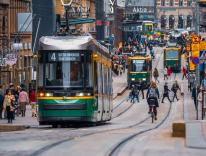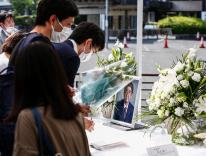MEETING THE MYSTERY
The survey of Masses in your parish issue (“An Ordinary Sunday,” September 22) certainly struck many chords with me, as I am a person who typically worships with different Catholic communities during the course of a year. The varied reports all raise different and interesting questions. Why are some celebrations truly special and others “routine”? Recently I heard two homilies, one on Mary and the other on John the Baptist. In both cases the priests emphasized the way in which each saint points you to Jesus. I use the same criterion to answer the question of what makes a particular celebration truly special. Why are some celebrations transparent, focused on the mystery, and others not? My answer is that the transparent ones are truly sacramental, outward signs of an inward grace and an eternal presence. Others are less transparent because celebrants, musicians, nearby congregants, or other actors make themselves the center of attention. That said, I do not absolve myself of often failing to seek the mystery myself.
J. Paul Martin
Barnard College
New York, N. Y.
WELCOME VISITORS
Scripture and church teaching make clear that Catholics should welcome visitors or newcomers from outside our communities and hold their perspectives in high esteem. To this end, Sunday Mass at Saint Thomas More, which I attend whenever I visit my parents in Atlanta, begins with an invitation to greet those around us in the pews “so that there are no strangers among us.” However, the blessing it is to take part in and reflect on another community comes with a responsibility to engage with it fully and thoughtfully, lest one judge another’s practices without understanding the assumptions that motivate them.
Unfortunately, Luke Timothy Johnson’s account of Saint Thomas More reveals a failure on his part to do so. Johnson may have found the selected hymns shallow and the use of a guitar jarring, but he neglects the outside observer’s key duty by failing to ask why the parish chooses to worship the way they do. After all, by his own account, a large and vibrant community appreciates Saint Thomas More’s liturgy enough to continue attending. This despite the alleged lack of “Jesuitical learning and wit,” qualities I have certainly never found lacking during my visits. The clue that more work was needed on Johnson’s part should have been the phrase “for some reason.” If an observer has not yet made the effort to learn what reasons lie behind another community’s traditions, I must question what value his or her observation adds.
Caleb Weaver
Medford, Mass.
COVER QUERY
The survey of parish Masses in the most recent issue of the magazine was an interesting portrayal of how diverse the “reception” of the post-Vatican II liturgical reform has been in architecture, music, and style of celebration. Yet the cover for the issue, while striking, was inappropriate, for what it portrayed was a moment from the Tridentine Mass and not from the Mass of Paul VI.
The large but broken host held together over a small paten was the gesture used by the priest in the Tridentine Mass while saying to himself the “Lord, I am not worthy…” just before he consumed all the host himself. The actual fraction was invisible to the congregation and had no connection to their own reception.
The latest General Instruction of the Roman Missal has made the fraction both public and theoretically essential to everyone’s Communion. As #321 in that text explains, the fraction’s purpose is to bring out “the sign of unity of all in the one bread, and of the sign of charity…[as] one bread is distributed among the brothers and sisters.”
Yet at the Mass I attended in Denver’s cathedral last July, the priest used exactly the gesture portrayed on the cover to do the invitation to Communion—and then ate all the host himself before getting a ciborium from the tabernacle for distribution to the people. He also had an ornate chalice from which he alone drank while the rest of the brothers and sisters shared cups that had been placed on the corner of the altar by the servers during the Presentation.
In short, the priest shared almost none of that meal with us. He gave us leftovers to eat and used the second-best tableware for us to drink from.
Maybe the lack of enthusiasm experienced in some of the parishes could be attributed to the fact that the core reality of the common meal has been neither preached nor enacted. And part of that much-needed catechesis could start with an appropriate cover picture next time.
Michael Marchal
Cincinnati, Ohio
MORE DESCRIPTION
As you know, I am an old devotee of Commonweal. I wanted to thank you especially for the “Ordinary Sunday” package.
It was obviously orchestrated in that each contributor began with a rich description of the venue. And that description set the tone: as Herbert McCabe and Stanley Hauerwas remind us, ethics is largely description.
We are used to analysis from your pages, so detailed descriptions are welcome, for they even make the familiar come alive.
If we look ahead to capture some new venues in U.S. Catholic life, you might think of a complement on Hispanic parishes. Or perhaps another theme. Either way, I wanted to encourage the pattern.
David B. Burrell, CSC
Hesburgh Professor Emeritus of Philosophy and Theology
University of Notre Dame
Notre Dame, Ind.
INEXHAUSTIBLE
My biggest takeaway from your reports on Sunday Masses in various parishes is that this could be your topic for each and every issue from now until the Apocalypse, and you would never exhaust the topic. So many dimensions to consider for your correspondents:
1. Visit an urban, suburban, or rural parish?
2. Visit an English, Spanish, or Mass in a different language?
3. Attend the Saturday Vigil, early dawn, 9:30 a.m. high Mass, or noon late-risers Mass?
4. Attend during Ordinary Time, Advent, Lent, or post-Easter?
5. Visit a parish with a pastor or a visiting priest?
6. Attend a Mass with a choir, cantor, or no music at all?
7. And let’s not forget, Catholic Mass happens seven days a week, not just on Sundays.
The variety of Masses has never ceased to amaze me, no matter how often I attend. Thank you for exploring, if only way too briefly.
Paul Conlin
Lake Zurich, Ill.
Please email comments to [email protected] and join the conversation on our Facebook page.
Share
Previous Story
Catholic Leaders Denounce Trump’s Immigration Cruelty
Next Story
What Almost Was


